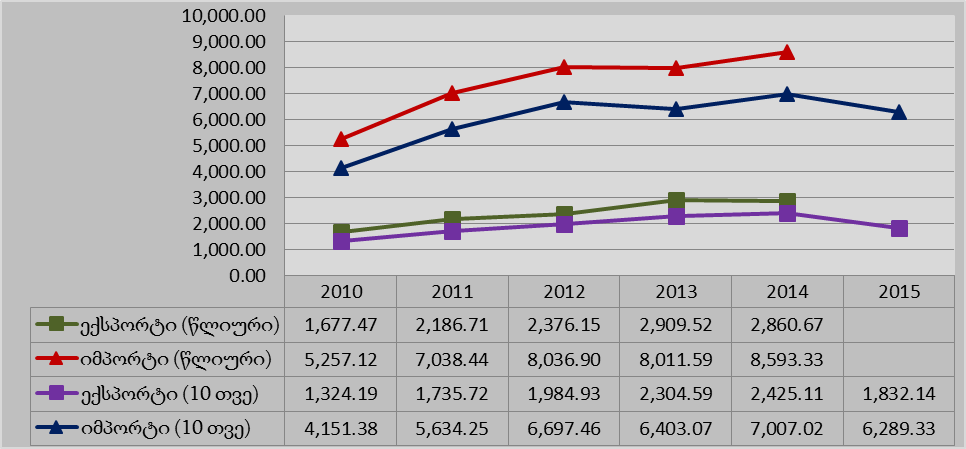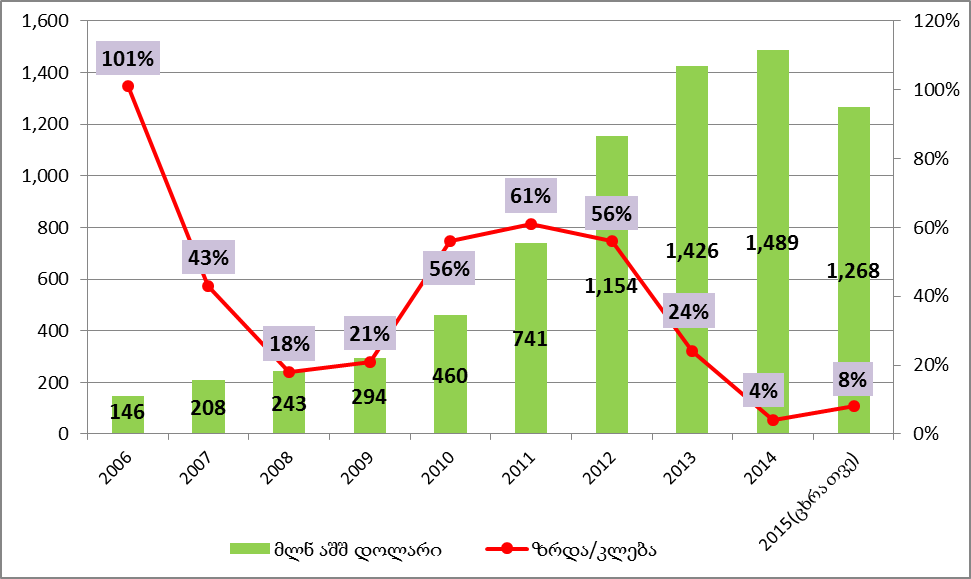During his speech at the plenary session of the Parliament of Georgia, the Executive Secretary of the United National Movement, Sergo Ratiani, stated: "During the previous years, the economy was growing and bureaucratic expenses grew with it. Today, bureaucratic expenses are being increased in parallel to the economic recession in Georgia. Bureaucratic expenses have increased by GEL 420 million."
FactCheck took interest in the MP’s statement and verified the accuracy of the facts he named.
The administrative (bureaucratic) expenses of the state budget are drawn up in the remuneration and goods and services budget lines. Sergo Ratiani is talking about Georgia’s annual state budget which is why we have analysed the expenses based upon the consolidated state budget. The consolidated budget is the sum of the state budget and those of the autonomous entities and local governments. It includes the administrative expenses of both the central government as well as the local level governments.
In 2016 (consolidated budget), the remuneration budget line increased by GEL 468 million as compared to 2012 whilst the goods and services budget line decreased by GEL 57 million. In total, administrative expenses in 2016 increased by GEL 411 million as compared to those of 2012. However, the growth of the remuneration budget line was partly due to removing the expenses of non-commercial entities and legal entities of public law from the subsidies budget line and including them in remuneration. We requested information from the Ministry of Finance of Georgia, asking for the amount of increase in the remuneration budget line based upon the aforementioned changes. According to the information received from the Ministry of Finance of Georgia, the transfer of non-commercial entities and legal entities of public law and the subsequent growth of the remuneration budget line happened in the case of the Ministry of Culture and Monument Protection of Georgia. The Ministry of Culture and Monument Protection of Georgia’s remuneration budget line increased by GEL 48.8 million in 2015 which was mainly due to moving the expenses of non-commercial entities and legal entities of public law which were subsidiary to the Ministry to its remuneration budget line. This amount was previously in the subsidies budget line.
We also obtained information that administrative expenses of non-commercial entities and legal entities of public law founded by Tbilisi City Hall were included in Tbilisi City’s overall remuneration budget line in 2016. This is more than GEL 50 million (see FactCheck’s article on this issue). In order to maintain impartiality, one must deduct the amount of money transferred from the subsidies budget line from the growth of administrative expenses. If we do this, it become clear that the overall growth of the state budget’s remuneration budget line in 2016 is GEL 370 million as compared to 2012 whilst the total growth of administrative expenses is GEL 313 million.
The administrative expenses of the consolidated budget increased by 4%-5% from 2010 to 2012. They dropped by 4% in 2013 and increased significantly (10%) in 2014. The growth of administrative expenses varied from 3% to 6% in 2015 and 2016; however, if we deduct the money transferred from the subsidies budget line, the percentage becomes even lower (1.2% in 2015 and 4.1% in 2016). As for the economic growth data, the economy increased from 6% to 7% in the period from 2010 to 2012 whilst the economic growth rate decreased significantly from 2013 to 2015. The forecast rate for 2016 is 3%.
Chart 1: Economic Growth and Growth of Administrative Expenses from 2010 to 2016
 In order to better understand the burden of government spending, we analysed the amount of administrative expenses with regard to the gross domestic product (GDP) of the country. According to the statistics from 2010 to 2016, the ratio of bureaucratic expenses to the country’s GDP decreased each year.
Chart 2: Share of Government Spending in Georgia’s GDP
In order to better understand the burden of government spending, we analysed the amount of administrative expenses with regard to the gross domestic product (GDP) of the country. According to the statistics from 2010 to 2016, the ratio of bureaucratic expenses to the country’s GDP decreased each year.
Chart 2: Share of Government Spending in Georgia’s GDP
 It should also be noted that the share of administrative expenses in the consolidated budget with regard to overall expenses has dropped. In 2016, about 34% of overall expenses are allocated for administrative expenses whilst in 2012 this was up to 41%. The share of administrative expenses in the overall expenses in the state budget has also decreased (see FactCheck’s article on this issue).
It is also important to note that bureaucratic expenses have not increased with regard to the growth of remuneration for high-ranking officials. The remuneration (wages, bonuses, surpluses) for ministers and deputy ministers was lower in the first nine months of 2015 than it was in the same period of 2012 (see FactCheck’s article).
Conclusion
According to the consolidated budget, administrative expenses have increased by GEL 411 million in 2016 as compared to 2012. However, the growth of the remuneration budget line was partly due to transferring the expenses of non-commercial entities and legal entities of public law from the subsidies budget line. If we deduct this amount, the administrative expenses in 2016 have increased by about GEL 313 million as compared to 2012.
The economy increased by 6%-7% from 2010 to 2012. The economic growth rate decreased significantly from 2013 to 2016. It should be noted that the growth of bureaucratic expenses should be considered not in absolute numbers (GEL million) but rather in ratios. The growth of wages of those employed in the public sector (including the police, soldiers, judges, scientists and so on) and the subsequent growth of administrative expenses cannot be considered as a negative step if the burden of these expenses on both the budget and the economy is decreasing. The share of administrative expenses in both the overall expenses of the budget as well as in the country’s GDP has been dropping annually from 2013 to 2016. In 2016, about 34% of overall expenses are allocated for administrative expenses whilst in 2012 this was up to 41%.
Hence, FactCheck concludes that Sergo Ratiani’s statement is MOSTLY FALSE.
It should also be noted that the share of administrative expenses in the consolidated budget with regard to overall expenses has dropped. In 2016, about 34% of overall expenses are allocated for administrative expenses whilst in 2012 this was up to 41%. The share of administrative expenses in the overall expenses in the state budget has also decreased (see FactCheck’s article on this issue).
It is also important to note that bureaucratic expenses have not increased with regard to the growth of remuneration for high-ranking officials. The remuneration (wages, bonuses, surpluses) for ministers and deputy ministers was lower in the first nine months of 2015 than it was in the same period of 2012 (see FactCheck’s article).
Conclusion
According to the consolidated budget, administrative expenses have increased by GEL 411 million in 2016 as compared to 2012. However, the growth of the remuneration budget line was partly due to transferring the expenses of non-commercial entities and legal entities of public law from the subsidies budget line. If we deduct this amount, the administrative expenses in 2016 have increased by about GEL 313 million as compared to 2012.
The economy increased by 6%-7% from 2010 to 2012. The economic growth rate decreased significantly from 2013 to 2016. It should be noted that the growth of bureaucratic expenses should be considered not in absolute numbers (GEL million) but rather in ratios. The growth of wages of those employed in the public sector (including the police, soldiers, judges, scientists and so on) and the subsequent growth of administrative expenses cannot be considered as a negative step if the burden of these expenses on both the budget and the economy is decreasing. The share of administrative expenses in both the overall expenses of the budget as well as in the country’s GDP has been dropping annually from 2013 to 2016. In 2016, about 34% of overall expenses are allocated for administrative expenses whilst in 2012 this was up to 41%.
Hence, FactCheck concludes that Sergo Ratiani’s statement is MOSTLY FALSE.
 In order to better understand the burden of government spending, we analysed the amount of administrative expenses with regard to the gross domestic product (GDP) of the country. According to the statistics from 2010 to 2016, the ratio of bureaucratic expenses to the country’s GDP decreased each year.
Chart 2: Share of Government Spending in Georgia’s GDP
In order to better understand the burden of government spending, we analysed the amount of administrative expenses with regard to the gross domestic product (GDP) of the country. According to the statistics from 2010 to 2016, the ratio of bureaucratic expenses to the country’s GDP decreased each year.
Chart 2: Share of Government Spending in Georgia’s GDP
 It should also be noted that the share of administrative expenses in the consolidated budget with regard to overall expenses has dropped. In 2016, about 34% of overall expenses are allocated for administrative expenses whilst in 2012 this was up to 41%. The share of administrative expenses in the overall expenses in the state budget has also decreased (see FactCheck’s article on this issue).
It is also important to note that bureaucratic expenses have not increased with regard to the growth of remuneration for high-ranking officials. The remuneration (wages, bonuses, surpluses) for ministers and deputy ministers was lower in the first nine months of 2015 than it was in the same period of 2012 (see FactCheck’s article).
Conclusion
According to the consolidated budget, administrative expenses have increased by GEL 411 million in 2016 as compared to 2012. However, the growth of the remuneration budget line was partly due to transferring the expenses of non-commercial entities and legal entities of public law from the subsidies budget line. If we deduct this amount, the administrative expenses in 2016 have increased by about GEL 313 million as compared to 2012.
The economy increased by 6%-7% from 2010 to 2012. The economic growth rate decreased significantly from 2013 to 2016. It should be noted that the growth of bureaucratic expenses should be considered not in absolute numbers (GEL million) but rather in ratios. The growth of wages of those employed in the public sector (including the police, soldiers, judges, scientists and so on) and the subsequent growth of administrative expenses cannot be considered as a negative step if the burden of these expenses on both the budget and the economy is decreasing. The share of administrative expenses in both the overall expenses of the budget as well as in the country’s GDP has been dropping annually from 2013 to 2016. In 2016, about 34% of overall expenses are allocated for administrative expenses whilst in 2012 this was up to 41%.
Hence, FactCheck concludes that Sergo Ratiani’s statement is MOSTLY FALSE.
It should also be noted that the share of administrative expenses in the consolidated budget with regard to overall expenses has dropped. In 2016, about 34% of overall expenses are allocated for administrative expenses whilst in 2012 this was up to 41%. The share of administrative expenses in the overall expenses in the state budget has also decreased (see FactCheck’s article on this issue).
It is also important to note that bureaucratic expenses have not increased with regard to the growth of remuneration for high-ranking officials. The remuneration (wages, bonuses, surpluses) for ministers and deputy ministers was lower in the first nine months of 2015 than it was in the same period of 2012 (see FactCheck’s article).
Conclusion
According to the consolidated budget, administrative expenses have increased by GEL 411 million in 2016 as compared to 2012. However, the growth of the remuneration budget line was partly due to transferring the expenses of non-commercial entities and legal entities of public law from the subsidies budget line. If we deduct this amount, the administrative expenses in 2016 have increased by about GEL 313 million as compared to 2012.
The economy increased by 6%-7% from 2010 to 2012. The economic growth rate decreased significantly from 2013 to 2016. It should be noted that the growth of bureaucratic expenses should be considered not in absolute numbers (GEL million) but rather in ratios. The growth of wages of those employed in the public sector (including the police, soldiers, judges, scientists and so on) and the subsequent growth of administrative expenses cannot be considered as a negative step if the burden of these expenses on both the budget and the economy is decreasing. The share of administrative expenses in both the overall expenses of the budget as well as in the country’s GDP has been dropping annually from 2013 to 2016. In 2016, about 34% of overall expenses are allocated for administrative expenses whilst in 2012 this was up to 41%.
Hence, FactCheck concludes that Sergo Ratiani’s statement is MOSTLY FALSE.
Tags:








